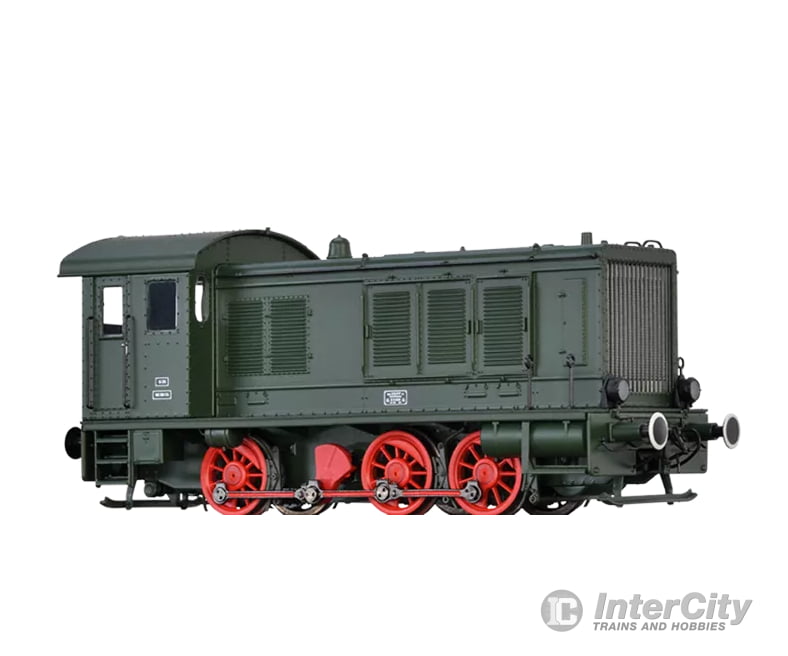Description
Model details
- Etched radiator grille (pototypically at models without radiator lamellas)
- Free standing handles and handrails
- Clear view through the driver cabin
- Lights equipped with maintenance-free LEDs
- Three-point support
- Finely detailed chassis
- Finest paintwork and printing
- Metal frame and wheels, structure made of plastic
- NEM-standard short-coupling
- Light change
- We use digital decoders developed by Brawa in cooperation with Doehler & Haass for models belonging to the BRAWA V36 range. The version Digital EXTRA is equipped with following features:
- Driver cabin lighting
- Filigree electronic coupling (interchangeable thanks to NEM-Norm)*
- Incl. Energy storage (buffers sound, motor and light)
- Extensive light functions: shunting lights, drivers cabin lighting, tail lights separately switchable
- Optimized lighting control for drive and shunting mode
- Flicker-free light, due to stabilized and through a separate capacitor buffered 5 V power supply
- Original sound
- Noiseless 16-bit Sound with up to 8 independent channels thanks to newest sound technology and excellent sound characteristics
- Optimal motor and load control for perfect running characteristics
- Applicable in all established digital systems (DCC, Motorola, SX1 und SX2)
- Enclosed Locomotive card in the AC-Version
- *It is possible to retrospectively convert the Diesel Locomotive V 36 from analogue to digital via a PluX22 interface (only sound functions). Please note that it is not possible to retrospectively convert the digital remote control coupling, the driven fan or the additional light functions.
Overview of technical functions
| Analog Basic | DC Dig Extra | AC Dig Extra | ||
|---|---|---|---|---|
| Driving function | X | X | X | |
| Light change | X | X | X | |
| Tail lights separately switchable | X 1) | X | X | |
| Driver cabin lighting | X 1) | X | X | |
| Shunting lights | X 1) | X | X | |
| Light setting programmable for analogue operation | X | X | ||
| Digital interface | PluX22 | PluX22 | PluX22 | |
| Decoder | X | X | ||
| Sound | X | X | ||
| Energy storage | X 2) | X 2) | ||
| Digital coupling (NEM-standard close coupling) | X | X | ||
| Locomotive Card | X | |||
| Additional information |
|
|
||
1) Function only available in digital mode
2) Storage capacitor for interruption-free travel in sections without current or on soiled tracks
Info about the original
One of the primary reasons behind the development of the 360 HP WR 360 C 14 diesel locomotive with fluid transmission was the demand made for the Wehrmacht railway facilities to be 'smoke-free'. The reason for this was to eliminate the possibility of locations such as ammunition depots or refineries to be detected from the air as a result of steam plumes generated by a steam locomotive. Thanks to a working partnership that included Berliner Maschinenfabrik AG (previously Louis Schwarzkopf), Orenstein & Koppel as well as Deutz and Voith (only for engine and transmission issues), two prototypes were created within one year which were then comprehensively tested by the German National Railway Locomotive Testing Office during the second half of 1937. The acquired knowledge was then immediately implemented into the further development so that further preliminary locomotives were manufactured as early as 1938. The first of the 245 volume production locomotives entered service at the start of 1939 and were supplied to the army, air force, navy as well as industrial companies. In doing so, the WR 360 C 14 trains were powered by Deutz or MWM engines that were also used in submarines at the time. During the Second World War, the WR 360 C 14 trains made it to many countries throughout Europe and even to North Africa, where some of them also remained. Consequently, several WR 360 C 14 were not only in use on the German Federal and National Railway after 1945; they were also running in countries such as Austria, France and Italy. Now operating under the V36 designation, the locomotives were primarily used in the shunting service and in front of transfer trains in the German Federal Railway. They were also used for suburban passenger transport in the greater Wuppertal, Frankfurt and Nuremberg areas. For this purpose, some locomotives were equipped with a simplified push-pull control or were converted to a one-man control system and equipped with a rooftop cockpit. This ensured that the locomotive staff had an improved view during journeys where the train was pushed. Further noticeable conversions to the Federal Railway locomotives included a larger and more striking cooling water expansion tank on the front end of the engine as well as adjustable radiator shutters. The last of these locomotives, then operating as the 236 range, remained in operation up until 1981. The V36 locomotives operated by the German National Railway were kept in operation for approximately 4 further years. Private railways and industrial companies continued to use some of the locomotives until the end of the 1980s and, even today, it is possible to experience several V36 locomotives in operation on various museum tracks.


